
Gaby Zavala holds a list in her hand as she makes her way through a maze of nearly 100 tents in a plaza in Matamoros, Mexico, looking for asylum seekers to assist that day. Her organization of volunteers, the Asylum Seeker Network of Support, had already identified a number of migrants who needed help with specific tasks such as case management, help finding temporary shelter, and navigating the dangers of living on the streets of Matamoros. Like most of the families she assists that day, a 23-year-old man from Honduras and his toddler have been living in the plaza next to the Brownsville & Matamoros International Bridge.The site is just an hour from the place where they were kidnapped en route to the US and held for ransom.

Gaby Zavala interviews the young man who was living in the Matamoros plaza with his daughter after being sent back to Mexico under the MPP. Photo: Garet Bleir
“He was petrified at being in Matamoros, living in constant fear that his kidnappers were looking for him and could find him,” Zavala says. “He was out in the open and staying at the plaza. He didn’t have shelter, family, or any form of protection for him and his daughter.” Lacking access to permanent shelters or assistance from the federal and local governments, many asylum seekers are left homeless in Matamoros, left to figure out daily survival while they navigate the threat of organized crime.
The Trump administration’s immigration policies and protocols have aggravated the problems within an already flawed immigration system while intensifying a system of abuse against migrants fleeing persecution and other hardships in their own countries. In many cases, those hardships are directly linked to US foreign policy which is often seen as a continuation of centuries of genocidal actions against Indigenous peoples of the “Americas.” It seems to continue along the boder as well, through family separations — a form of genocide according to the UN Genocide Convention — as well as the mass detainment of migrants in detention centers under inhumane conditions, the refusal to vaccinate children in facilities where flu outbreaks have already led to death, and frequent abuse within the facilities; as well as the Administration’s current policy of forcing asylum seekers to wait for permission to enter the United States in some of Mexico’s most dangerous locales. At every step of this process, migrants are forced to navigate a system that has become increasingly hostile towards even their most basic human rights.
Many of the migrants coming to the United States are fleeing persecution in their homelands. They suffer for months on an arduous trip from Central America to the US-Mexico border only to be forced into further trauma as they wait in danger at the ports of entry — sometimes for months before being allowed to cross into the US. But it doesn’t end there: upon arrival they are held in detention centers where many end up being grievously mistreated by government employees.
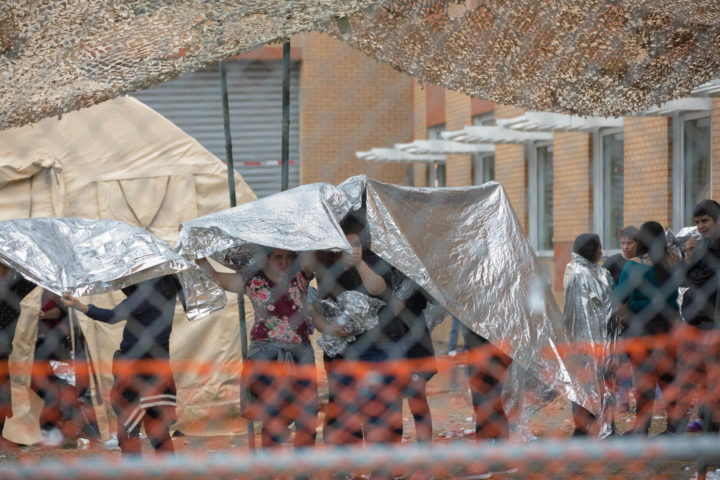
While awaiting processing, migrants, mostly women and young children, were forced to remain outside the U.S. Border Patrol McAllen, Texas Station through nearly 100° F heat and severe thunderstorms, protected by only thin mylar blankets and sleeping on the ground. Photo: Garet Bleir
Now, under the so-called Migrant Protection Protocols, asylum seekers can no longer stay in stafety with family members or sponsors in the US while they await their immigration proceedings. Instead, they are sent back into Mexico to face further danger and trauma.
It is these Migrant Protection Protocols that has brought Zavala to interview the young man sitting with his toddler on a bench in the plaza, under a blazing sun on a day that nears 100 degrees. “They were fleeing their original country of Honduras because the gentleman’s wife, the little girl’s mother, was killed in their country,” Zavala says. The young man told Zavala, who is director of the Brownsville Migrant Respite Center in South Texas, that before arriving in Matamoros, both he and his daughter had been kidnapped and put up for ransom in Reynosa, Mexico, just an hour west along the Texas border. He says his kidnappers called his sister in the US and demanded a $3,000 ransom. His sister paid about $600, and while she tried to come up with the rest of the money, the young man was able to escape with his daughter.
After escaping, he crossed over to the US to ask for asylum. He was processed by officials and then sent back into Matamoros under the Migrant Protection Protocols.
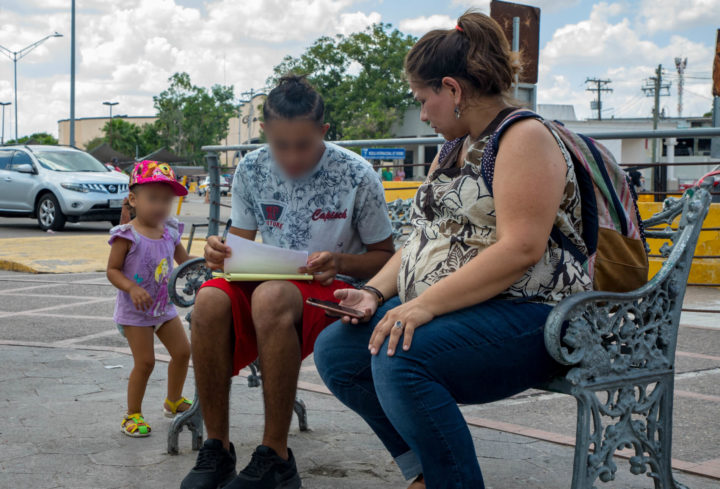
The young man and his daughter were kidnapped and ransomed in Reynosa, Mexico. They were able to escape and request asylum in the US, only to be sent back under the protocols. Photo: Garet Bleir
Zavala had initially planned to connect the two asylum seekers with an attorney to file an appeal. But knowing that she had to act quickly, she utilized connections with Brownsville Congressman Filemon Vela Jr. and secured an interview for the young man with immigration officials. After a three-day process, officials verified his story, paroled him in the US, and reversed the previous decision — removing him from the Migrant Protection Protocols. He is now with his family and sponsors in the US.
Many times, grassroots activists like Zavala serve as the liaisons between migrants in Mexico to the resources in the US. Without these organizations, many asylum seekers would be left without any hope of securing safety and without any of the resources or donations that the asylum seekers survive on. Approximately 500 asylum seekers are living in the Matamoros plaza — out of tents donated by humanitarian organizations, eating food provided by volunteers, bathing in the Rio Grande and sharing just two overflowing portable toilets, all the while evading gang and cartel predators and hostile officials from two governments. They are hesitant to leave the central plaza, because they are more susceptible to kidnappings and extortion elsewhere, Zavala says.
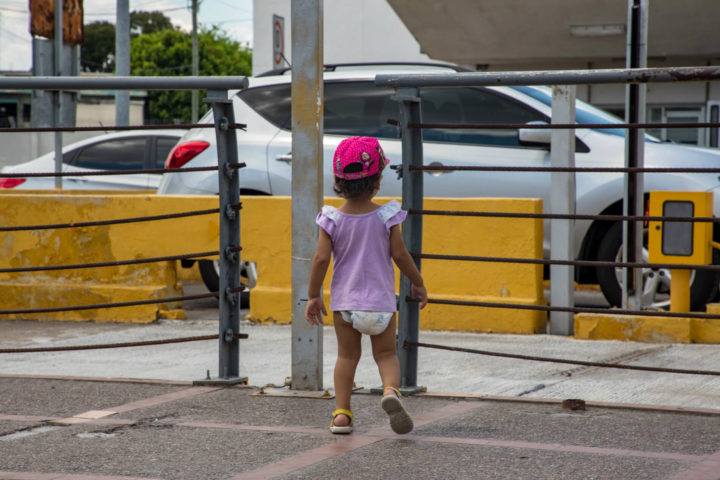
Toddler who was living in the Matamoros plaza with her 23-year-old father after being sent back to Mexico under the MPP. Photo: Garet Bleir
“There is no safety. There is no family. There is no home. There is no healing here,” Zavala says. “We see the denial of migrants’ basic human and civil rights. Our job is to make sure that we fight for those rights at every single corner.”
In response to the MPP, grassroots activists have rapidly mobilized to assist those now stuck in Mexico. Zavala started the Asylum Seeker Network of Support as a result of the humanitarian work she began on the Mexican side of the border last year. While crossing the border daily for months to prepare meals for asylum seekers, “it became apparent that the problems ran much deeper than just the need for food and supplies,” she says. “There were more sinister things at play, like extortion, kidnappings, threats at the hands of organized crime and/or Mexican authorities, as well as sexual coercion and human degradation that I could no longer throw a blind eye to.”
It was at this point Zavala realized that she needed to be advocating for the rights of these immigrants by fighting policies such as metering, and now the implementation of MPP. As a result, this became one of the main missions of the Asylum Seeker Network of Support, in addition to its direct aid efforts. Zavala says the organization is always in need of volunteers to provide and cook the food, as well as monetary donations to help put families in appropriate housing. In addition to direct aid, the organization provides basic legal clinics, case management, consultations, connects asylum seekers with sponsors in the US who can help with funding basic medical needs, shelter, food, and supplies. Neither the Mexican nor the US government offers much in the way of resources to assist the asylum seekers, Zavala says, aside from Mexican officials offering them a bus ticket straight back home.
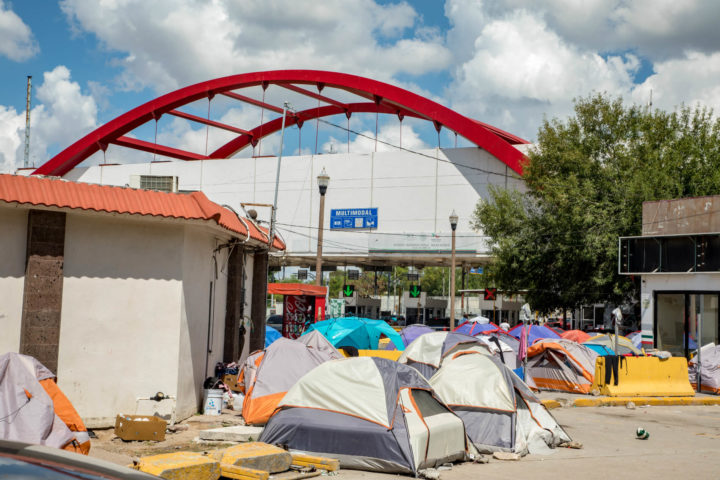
Matamoros, Mexico plaza adjacent to the Brownsville & Matamoros International Bridge where upwards of 500 asylum seekers are forced to live after being sent back to Mexico under the Migrant Protection Protocols. Photo: Garet Bleir
“People are dying from US policy and so we do lifesaving work. I want to make it loud and clear that it is citizens opening up their hearts, doing things on our own time, and oftentimes using personal funds to help these people. It’s overwhelming and shocking at times that the only help that people can get is from humanitarian efforts like ourselves.”
The CBP and ICE Detention Centers for migrants that Zavala references are now being referred to by many people as concentration camps.
According to the Merriam-Webster dictionary, a concentration camp is “a place where large numbers of people (such as prisoners of war, political prisoners, refugees, or the members of an ethnic or religious minority are detained or confined under armed guard.”
These facilities have come under fire for subjecting parents and children to verbal, emotional, sexual, and physical abuse, under conditions that have led to some of their deaths.
“In concentration camps, they utilize methods terrorizing people, of limiting their basic rights, of tearing people’s emotional and mental health down to exert authority over people,” Zavala says. “And that is what is happening in these centers. They’re not just being detained; they’re being broken down as individuals. They’re being treated like animals, as subhuman.”
It’s easier to control people after they are emotionally and mentally broken down — and that is exactly what is happening inside of these detention centers, Zavala says. “I know because I talk to migrants daily when they’re released. I hear it from people in the masses that have been treated that way in these centers,” she adds.
But the abuse did not start with President Trump. There has long been a culture of abuse within CBP and ICE as noted through newly released documents. In mid-October, the ACLU Foundation of San Diego and Imperial Counties published approximately 35,000 pages of heavily redacted material from DHS, ICE, and CBP after a lengthy legal battle. The documents outline abuse and neglect of unaccompanied immigrant children in US CBP and ICE custody between 2009 to 2014 including denial of medical care, verbal threats, physical and sexual abuse, and inhumane detention conditions.
It’s easier to control people after they are emotionally and mentally broken down — and that is exactly what is happening inside of these detention centers
Within these documents, children described being run over with vehicles, stomped on and kicked, tased, and punched as well as a wide range of verbal abuse. One complaint against ICE detailed an agent that told child detainees he was transporting to “’shut the f*** up’ and threatened that ‘if I hear any s*** in the van I’m going to smash your f***ing faces in,’” the documents read.
Throughout the complaints, children noted being deprived both of drinkable water as well as edible food and held in unsanitary and freezing cells with “inadequate bedding and no access to personal hygiene items.” Children also reported being threatened with death and rape, told to remove their clothes before being questioned, and CBP officials inappropriately touching them. After Trump’s inauguration it is clear that these abusive conditions did not improve but in many cases continued and intensified.
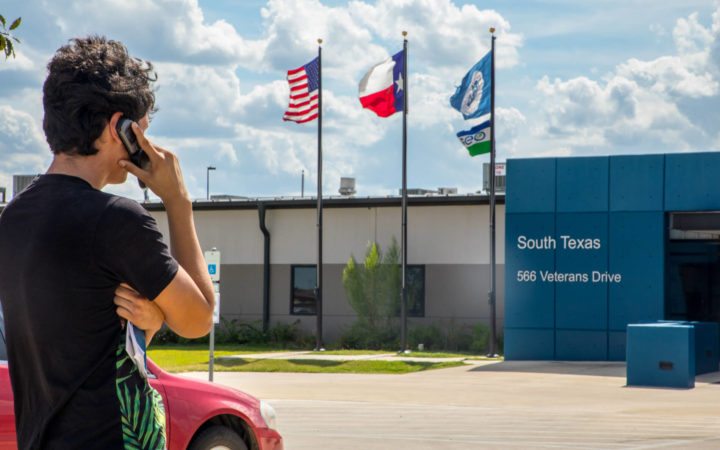
Francisco Erwin Galicia, a high school senior born in Dallas, Texas calling his mother for the first time after being released from nearly a month of illegal detainment in U.S. Detention Centers. Francisco’s full story is explained at the end of this piece. Photo: Garet Bleir
Struggles of navigating the asylum process are compounded for many of those who are of Indigenous descent — which includes an enormous proportion of the asylum seekers, Zavala says. “When they come up here, oftentimes they don’t speak either Spanish or English or even a dialect that we can understand.”
This adds another layer of complexity; because, without translators, basic information often can’t be communicated. “We can’t explain to them their immigration documents, that they’re going to go through a checkpoint, or they might be returned to Mexico — or ‘these are the ways that you can protect yourself.’”
“Everyday my heart cries, my soul dies a little bit more because I cannot believe that in this day and age, we are still treating people this way, and we’re still committing horrible atrocities against people of color, minorities, and indigenous people,” Zavala says. “MPP sounds like it’s for the wellbeing of everybody, but what we’re seeing is how these policies translate to reality and its absolutely horrid. By using terms like Migrant Protection Protocol, it lets the entire country stay unaware of the reality. It misleads people thinking that they’re being taking care of. I’ve heard of the MPP being renamed as Migrant Persecution Protocols. That’s more descriptive of what’s happening.”
Hundreds of people from different regions and Indigenous nations came together at the Taking a Stand on Our Stolen Land event led by the Esto’k Gna Nation (Carrizo/Comecrudo Tribe of Texas) in July in McAllen, Texas. Numerous speakers from various Indigenous nations lambasted what they and many others view as the government’s inhumane response to migration. They were painfully aware of a reality that has barely registered in the media coverage of the crisis: a large proportion of these migrants are Indigenous to Central America. They came to the event to remind others that these are the same genocidal and racist policies Native Americans have endured for over 500 years.

Jeremy Black Bear of the Oglala Sioux Nation, Duwayne Redwater of the Standing Rock Sioux Nation, and Ruth Garcia of the Carrizo/Comecrudo Tribe of Texas smudge, pray, and sing for migrants at the Catholic Charities Respite Center in McAllen, Texas. Photo: Garet Bleir
“This is an administration that separates and cages children and asylum seekers and bars people from coming to our country based on who they are, or how they worship,” Rep. Deb Haaland told the assembled crowd. Haaland is a member of the Pueblo of Laguna, representative of New Mexico’s first congressional district, and one of the first two Native American congresswomen. “They will feel this trauma for the rest of their lives, and far into the future. We must ensure that people have justice – what this country is supposed to stand for.”
“Racism and bigotry should never fuel any administration’s policies,” she continued. “Native Americans know all too well the long-lasting trauma of government-enforced family separation. Our communities still struggle with the lasting impact that cruel assimilation policies have had.”
To many Native Americans, like Rep. Ruth Buffalo of North Dakota, another speaker at the event, what is happening now at the US’s southern border is not new, but rather a horrific repeat of a history they or their parents experienced firsthand. The family separations occurring now at the border harken back to the horrors of the boarding school era (1860-1973) in which hundreds of thousands of Native American children were forcibly separated from their parents by the government and Catholic Church in order to assimilate them. Yet again, Indigenous children are being separated from their families and held in abusive situations. But this time, the children were born in Mexico and other countries in the politically-troubled subcontinent below.
Buffalo, a citizen of the Mandan, Hidatsa and Arikara Nation, is the first Native American Democratic woman elected to the North Dakota Legislature. “My mom was sent to a boarding school at the young age of five, where she was punished for speaking her language,” she told the participants at the Stolen Land event. “Some of her friends who were boys. They were successful in hanging themselves the night before they were to get their braids cut off,” Rep. Buffalo says. “So what is happening today in 2019 is unfathomable — and we cannot repeat history. We need to tell our true history because if we don’t acknowledge the blood that has been shed on the ground, we will continue to see genocide.”
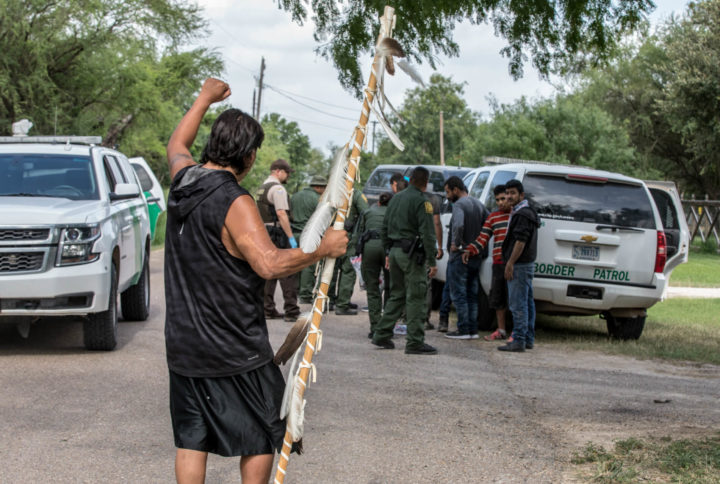
Jeremy Black Bear of the Oglala Sioux Nation, Duwayne Redwater of the Standing Rock Sioux Nation, and Ruth Garcia of the Carrizo/Comecrudo Tribe of Texas smudge, pray, and sing for migrants at the Catholic Charities Respite Center in McAllen, Texas. Photo: Garet Bleir
To Indigenous Peoples like the Esto’k Gna, there’s also a problem with the line that separates the US from Mexico. To the Esto’k Gna, who traditionally live in Somi Se’k (South Texas, northern Mexico, and eastern New Mexico) on both sides of the Rio Grande, that river is not a border but rather a sacred being. It is known as Spirit River or Ahumatau Mete’l in the Esto’k Gna’s language of Hokum.“Just because a lot of the Esto’k Gna crossed that river, doesn’t mean that’s Mexico and this is the United States,” says Juan Mancias, the Chairman of the Esto’k Gna Nation (Carrizo/Comecrudo Tribe of Texas). “That’s still Somi Se’k,” Mancias says. “That’s still where our people live over there. Our relatives live over there.”
For untold millennia, Indigenous nations across the Western Hemisphere crossed these colonizer-made borders through ancestral trade routes spanning the continents.
“There were trade routes down to Tierra Del Fuego, all the way up to the Arctic Circle, and there are native people there we have some connection with in some way,” says Mancias. “We are of one people of this land, and there’s an inherent right to migrate. These people are coming and seeking asylum from being oppressed themselves. They shouldn’t be oppressed here by people that don’t have any claim to this land.”
“Embracing my Indigenous background made a lot of people uncomfortable. But I realized I’m not here to make anyone comfortable with who I am, ever,” says Sema Hernandez, a Democratic candidate for the US Senate from Texas. Standing on the banks of the Rio Grande at a bend in the river at the National Butterfly Center — which is now under threat of border wall construction — Hernandez remembered the story her mother told her of when she crossed that river at 14 years old, coming to the US looking for a better life. “What I do every single day from that moment that I knew my mother’s story is understanding that the struggle to come to this country is not to take away from anyone, it’s for us to grow and for us to have a better life.”
About the detention centers currently detaining asylum seekers and their children, she says, in reality, they are concentration camps. “These concentration camps are just extensions of the white supremacy and capitalism upon which this country was built — on the bloodshed of our ancestors. No one is illegal on stolen land,” Hernandez says in reference to the land the US stole through centuries of illegal land grabs, genocide, and broken treaties. “We know that these white supremacist, capitalistic wars are causing problems all around the world, displacing many people. Now they are incarcerating us for trying to survive and coming here for a better life.”
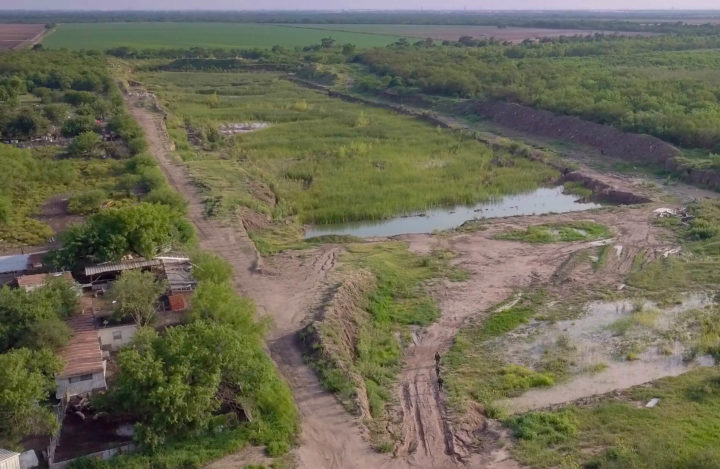
Border patrol searching fields in San Juan, TX. Photo: Garet Bleir
As Hernandez mentions, the mass emigration from Central America and other areas can be traced back in part to US interventionism which frequently destabilizes Southern countries.
Honduras now suffers from gang violence, poverty, and corruption ravaging its communities. A 2017 report from the Alliance for Peace and Justice (APJ) notes that, of over 27,000 homicides in Honduras between 2010 and 2013, just over 1,000 or 3.7 percent resulted in convictions. The US-backed military coup that sent democratically-elected President Manuel Zelaya into exile in 2009, is one cause of that ongoing violence — not to mention the decades of US-sponsored civil wars throughout the region in the 1970s and ’80s. Thousands of Honduran migrants flee each month from their homelands to make an arduous journey north. They travel thousands of miles while navigating prejudice, oppression, and a labyrinth of government bureaucracy at every step; all to obtain asylum in a country that is complicit in the very coup that contributed to their persecution in the first place. Yet these asylum seekers arrive at the US border to an administration that is anything but welcoming.
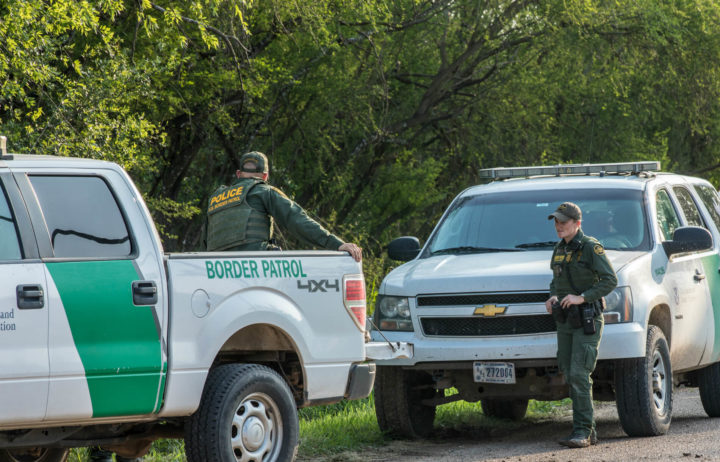
Border Patrol detainment just outside the Eli Jackson Cemetery in San Juan, TX where the Carrizo/Comecrudo Tribe has set up a village in resistance to the border wall and in protection of final resting places of Esto’k Gna ancestors and relatives. Photo: Garet Bleir
Another contributor to the mass emigration is the US government’s disproportionate contribution to the global climate catastrophe.
As the climate catastrophe worsens, those least responsible for dismantling the environmental balance are already starting to become the ones most affected by it. In Guatemala, climate change has forced many Indigenous peoples to flee North. Many communities that once survived on subsistence farming are no longer able to sustain themselves because of constantly failing harvests.
“It clearly emerges from several studies that climate change and emigration are strongly linked,” notes a 2017 United Nations report, with a clear link between emigration from Guatemala, Honduras, and El Salvador and the food insecurity of individuals there. Agricultural losses and climate events such as drought, higher temperatures, and prevalence of pests have led to a decline in food production and, in turn, in available agricultural work opportunities. The report also noted that poverty, unemployment, and violence had been significant causes of emigration in those areas. These migrants are forced to flee their homelands to the US, a country that has the second-highest total carbon dioxide emissions from fuel combustion in the world with a per capita rate over two times that of the number one emitter overall — China, according to data from the International Energy Agency.
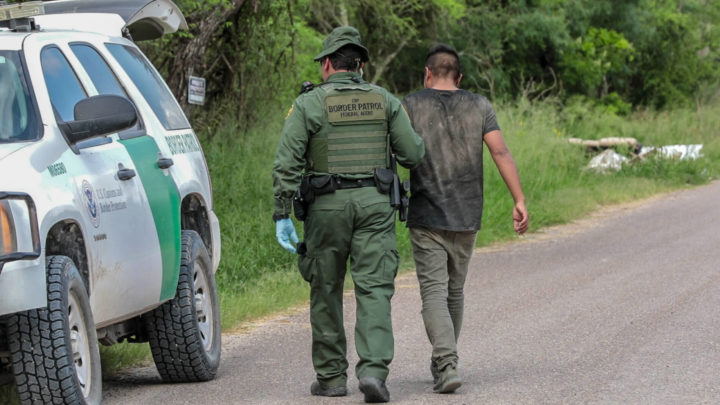
Border Patrol detainment just outside the Eli Jackson Cemetery in San Juan, TX. Photo: Garet Bleir
Instead of addressing these problems through policy aimed at revitalizing Central America so that migrants don’t have to leave their homelands, the Trump Administration has decreased aid to Central American countries and has threatened to continue if they don’t take actions to decrease the number of their citizens headed to the US in search of asylum. Far from solving this problem, many experts believe decreasing aid in this way will result in exacerbating the conditions that many migrants are fleeing.
For asylum seekers who make the arduous journey to the US, the chances of finding refuge are slim with leaders becoming increasingly hostile towards migrants. A new case against the Trump Administration — filed by attorneys affiliated with the ACLU — exemplifies these antagonistic policies and protocols. One of the plaintiffs, referred to in the lawsuit as Dinora, is a citizen of Honduras. There, Dinora, along with her 18-year-old daughter, had been threatened with death and repeatedly raped by MS-13 gang members, the lawsuit reads. The two fled to Mexico and found refuge in a shelter, but members of MS-13 found them again and threatened them. So Dinor and her daughter made the nearly 3000-mile trip to the US from their homelands in search of refuge. Once there, they presented themselves in three separate instances at an official port of entry in Tijuana. However, each time the two were denied asylum because CBP officials misinformed the two of their rights, and so they were repeatedly forced to return to Tijuana, the lawsuit states. The first two times they were told that there was no asylum available for them, while the third time Dinora was told she could come through but had to leave her child behind. When Dinora insisted that she and her daughter had a right to seek asylum, CBP officers escorted the two away from the port of entry. It wasn’t until this lawsuit was brought forward that the government allowed the mother and daughter entry into the US.
In an amended complaint to the pending lawsuit Al Otro Lado v. Nielsen, the SPLC is fighting against the administration’s “Turnback Policy,” challenging the practice of turning back asylum seekers at legal ports of entry along the US-Mexico border. The lawsuit calls out a formal policy enacted by CBP and DHS to restrict migrant access to the asylum process at points of entry. Under the Turnback Policy, it was mandated that “lower-level officials directly or constructively turn back asylum seekers at the border” which the plaintiffs say is in violation of US law. The government did this, the SPLC says, through lies, threats, coercion, verbal and physical abuse in addition to unreasonable delays, threats of family separations, and denials of access. In May, attorneys argued against the government’s second motion to dismiss this lawsuit, and on July 30, a federal district court rejected the government’s attempt.
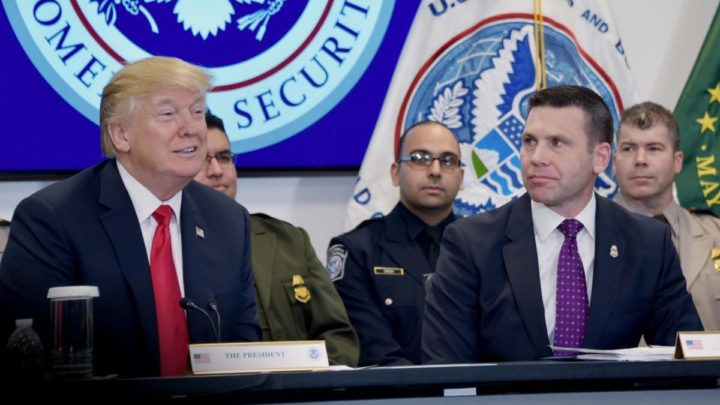
President Trump attends a briefing about illegal immigration with Acting Homeland Security Secretary Kevin McAleenan.
As the lawsuit purports, instead of making amendments to existing law, the administration is breaking it. Under US policy and the Immigration and Nationality Act, the federal government is required to inspect and process individuals seeking asylum who have a fear of returning to their home country due to dangers including threats of persecution, torture, or death. However, activists, advocacy organizations, and the news media have documented thousands of cases wherein the US government has not granted asylum seekers access to the asylum system.
The SPLC has also documented numerous cases of CBP officials misinforming asylum seekers of their rights. The organization reported border officials lying to migrants saying, “Donald Trump just signed new laws saying there is no asylum for anyone” and noted four Guatemalan asylum seekers who at a Texas Point of Entry were “turned away after CBP officials told them that ‘Guatemalans make us sick.’” In May of 2018, former DHS Secretary Kirstjen Nielsen confirmed the Turnback Policies existence in a statement discussing “metering.” In September of that year, a report from the OIG noted that “CBP was regulating the flow of asylum-seekers at ports of entry through ‘metering,’ a practice CBP has utilized at least as far back as 2016 to regulate the flow of individuals at ports of entry…and likely resulted in additional illegal border crossings.” But for those crossing legally, this policy forces migrants to remain in Mexico border towns where they are routinely in danger of kidnapping, theft, rape, trafficking, and murder.
The Trump Administration has essentially turned this illegal Turnback Policy into official policy through the Migrant Protection Protocols (MPP), also known as the Remain in Mexico Policy. The policy went into effect in January and it forces Central American asylum seekers to await their immigration proceedings in Mexico. After crossing the border into the US, asylees are processed and immediately sent back into Mexico. Many individuals have already established sponsors in the US or have family living in the US; but they are now left unable to receive assistance from them in the US while they await their immigration proceedings.
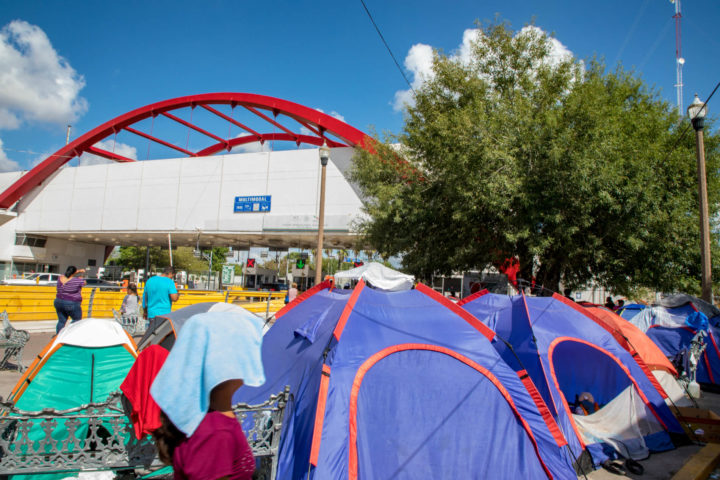
Matamoros, Mexico plaza adjacent to the Brownsville & Matamoros International Bridge where upwards of 500 asylum seekers are forced to live after being sent back to Mexico under the Migrant Protection Protocols. Photo: Garet Bleir
Another federal lawsuit headed by the ACLU, SPLC, and Center for Gender & Refugee Studies challenges MPP. The organizations say the Trump Administration is violating the Immigration and Nationality Act and the Administrative Procedure Act, and the US has a duty under international human rights law not to return people into dangerous conditions.
Immigrant advocates say that the title of Migrant Protection Protocols is misleading. “The migrant protection protocols don’t protect the migrant,” says Zavala, the director of a migrant respite center in Brownsville, Texas. “They’re forced to wait in Mexico wherein very few have sponsors or family members that can take care of them financially or offer the shelter that many had expected to find in the US.”
An official statement from the White House says that, “Mexico will provide [those sent back to Mexico under MPP] with all appropriate humanitarian protections for the duration of their stay.” But this is not the case. In just the city of Matamoros, around 500 asylum seekers sent back under MPP are living next to the Matamoros and Brownsville International Port of Entry, dwelling in tents and living on food that have been provided by humanitarian organizations and volunteers.

Children asylum seekers making crafts during the Sidewalk School. Photo: Garet Bleir
“People have already suffered many months on the trip from Central America to Mexico, many months in Matamoros or at the ports of entry to cross over to seek asylum,” Zavala says. “Then they’re held in US detention centers where they’re mistreated, treated as subhuman, and treated as criminals when they haven’t committed a crime. Then, instead of now going with family members who have a home, a loving environment, and perhaps a way to heal from all that trauma, now they are sent back to the country where they’re in extreme danger.”
“There is no safety. There is no family. There is no home. There is no healing here,” Zavala says. “We see the denial of migrants’ basic human and civil rights. Our job is to make sure that we fight for those rights at every single corner.”
The Trump Administration has released a statement contending that, “MPP will help restore a safe and orderly immigration process, decrease the number of those taking advantage of the immigration system, and the ability of smugglers and traffickers to prey on vulnerable populations, and reduce threats to life, national security, and public safety, while ensuring that vulnerable populations receive the protections they need.” However, in many cases, these protections are not being provided and the policy is furthering the migrants vulnerability to the many threats they face.
“There is no safety. There is no family. There is no home. There is no healing here.”
While the young man from Honduras and his daughter were able to gain asylum, thousands are still left waiting in Mexico with their lives in danger. In the same plaza, a group of LGBTQ asylum seekers was hoping to secure housing through Zavala and the Asylum Network of Support obtained through sponsors in the US. Everyone who is returned to Mexico has already been processed through a detention center on the US side. After being processed in the US, this group of LGBTQ asylum seekers had been returned to Mexico under MPP.
In Mexico, LGBTQ asylum seekers run a greater risk of danger than most non-LGBTQ individuals, Zavala says. “There is a far higher risk for hate crime, and so they are not supposed to be returned to Mexico. However, we’re seeing that upholding even basic policy is not being honored by the US immigration system.”
This group has an attorney who has been trying to help them reenter the US, making a case that the immigration officials should not have returned them to danger in Mexico. However, those requests were ignored, she adds.
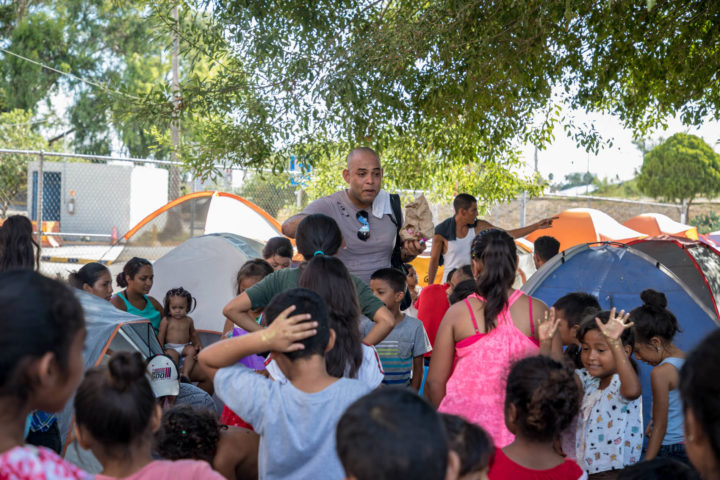
Sidewalk School Teacher Tito Vazquez teaches a group of children asylum seekers how to count in the Matamoros plaza adjacent to the Brownsville & Matamoros International Bridge. Photo: Garet Bleir
Ray Peña, an asylum seeker who is part of the LGBTQ community, fled persecution from his home country of Cuba last April. “Being openly gay was very hard for me. I was personally persecuted and threatened to be beaten and killed by the police, who are very homophobic as well,” he says. Ray was teaching at a university and was fired for his sexual orientation, he says, adding that “after that [it] was impossible for me to actually get a proper job.”
Ray crossed seven countries to make it to the US, initially traveling to Panama, then to Costa Rica, Nicaragua, Honduras, Guatemala, and Mexico, before finally being processed in the US, then sent to Mexico under MPP. “You have to cross all the borders illegally, and end up being guided by people you don’t know in the middle of the night, in the jungle, with God knows what animals and dangers that are lurking. You never know what’s going to happen,” he says. Ray recalls having to climb a mountain on the way to the US when he sprained his ankle, forcing him to remain in bed for seven days before he could continue. “I was lucky to get here, but there are people who have lost their lives on the way here. It’s not something to take lightly, and it’s very hard, to be honest. If we do this, it’s because we need to, not because we want to; it’s just that we want to be free.”
He made the long trip to the US-Mexico border in about a month, where he waited another three months before he was finally allowed to cross in August. But the dangers and hardships haven’t ended for Ray. After being processed in the US, he was given an October court date and sent back to Matamoros to wait. He has now been waiting in Matamoros for over four months.
It’s been hard for those living in the plaza, he says, with virtually no food, no water, and just two overflowing portable toilets for around 500 people. “It’s dangerous to be here. There has been a lot of kidnapping and extortion. There has also been a lot of murders and shootings recently, so it’s quite dangerous,” he says. People don’t want to leave the plaza, so they stay around this area, and it is becoming completely crowded. And then if you venture out, you can do it, but it’s at your own risk.”
While waiting in Matamoros, Ray decided to volunteer his time to the education of children waiting by his side. He joined the Sidewalk School in the plaza as a teacher. The Sidewalk School teaches the children, ages 3 to 10, most of whom live on the Matamoros plaza. Felicia Samponaro, a grassroots organizer from Brownsville, Texas, had been seeing the same children in the plaza week after week and suggested the idea of holding a school to Ray and other asylum seekers. She then started a non-profit to make it a reality.
IC interviewed Ray as another teacher is talking to around 30 migrant children, hands covered in glitter from an art project they were working on and sitting on mats they laid on the ground of the plaza. Most of the children haven’t gone to any form of school, so Ray and other volunteers focus on the ABCs, some math and counting, along with art projects, singing, and dancing.
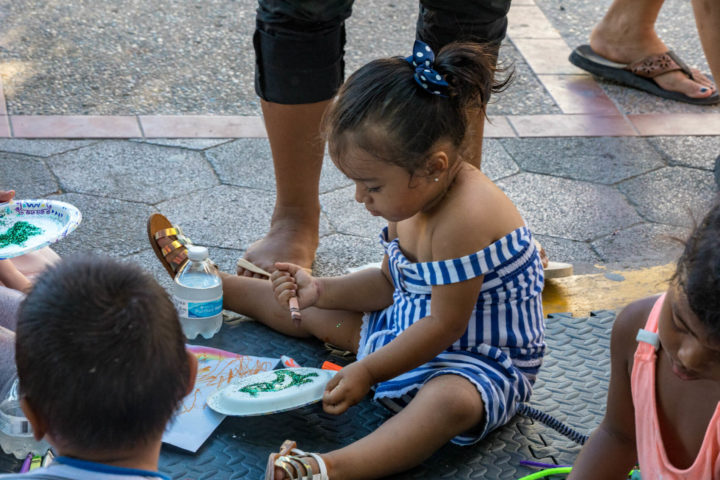
A young asylum seeker making crafts during the Sidewalk School. Photo: Garet Bleir
Some children could legally go to school here in Mexico while they wait for their asylum claims to be met. But public schooling in Mexico is not completely free — at times requiring purchases for books, uniforms, and lunch, in addition to transportation.
Ray also noted the danger that children and families would have to face if they enrolled in a school because they would have to take the kids out of the plaza each day to the closest school. “How someone living here can have a kid in the morning ready with clean clothes, fed, with food to get home, and food for school – someone who’s living here, and eating from the food that the volunteers are bringing – it’s actually not feasible in any way,” Ray says. “That’s why we started doing this.”
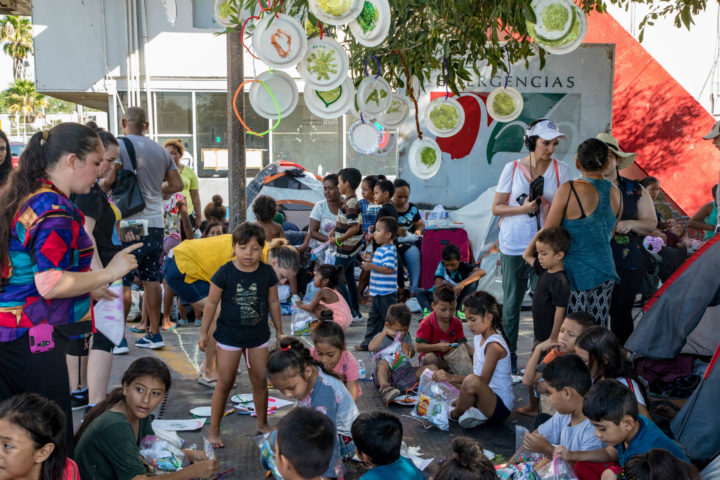
Decorating a tree in the plaza with the finished crafts created during the Sidewalk School. Photo: Garet Bleir
A 2019 letter to DHS from organizations including the American Immigration Council and American Immigration Lawyers Association presented the results from a survey of over 500 border crossings from early 2019 arrivals. The organizations noted over 90 percent of respondents saying they did not feel safe in Mexico; nearly half reported that they had experienced at least one type of harm while in Mexico, and over a third said they were mistreated by Mexican police. The letter also included testimonies from ten families that had experienced violence and harm on the Mexican side of the border – including rape, beatings, kidnappings, and ransom.
One testimony noted within the letter that an Indigenous Guatemalan woman by the pseudonym of Maybelin, along with her 2-year-old daughter, were persecuted in their homelands due to their Indigenous identity. On the way to the US, Maybelin was sexually assaulted numerous times in Mexico at a house where she was staying. In her testimony, she said she was forced to stay at the location until she was able to enter the US: “I felt that I could not leave that unsafe situation, because I had nowhere to go in Mexico, and I had heard that the Mexican police did not protect migrants and might even deport me back to danger in Guatemala.”
Some migrants have chosen to circumvent the points of entry in their asylum process in fear that their claims won’t be taken seriously, granted, or otherwise successful; or due to the fear of being separated from their child.
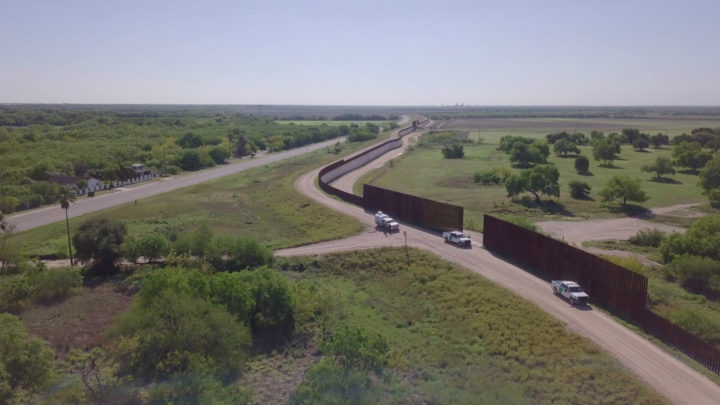
Border Patrol patrolling near border wall construction in Penitas, TX. Photo: Garet Bleir
“A lot of times we see that what happens because of all that compound stress, compound trauma, and compound layers is that people give up, lose hope, and sometimes they grow desperate to cross the river. Some drown in the process,” Zavala says. “There was an incident where a mother and a small child drowned trying to get to the US through the river,” she adds, referencing a migrant mother and her young child who attempted to cross the Rio Grande after being returned to Matamoros under the MPP.
“The United States, since the beginning of colonization, have oppressed people and have committed atrocities to people of color and to Indigenous people. Everybody seems to say the US is so great, but to become that we’ve had to cover up all of the horrible atrocities we’ve inflicted on people. This is the same thing that’s happening now, creating a culture of aggression against people of color and covering it up with terms like migrant protection protocols,” she adds.
At least 90 people have died due to encounters with US border agents since January 2010 with many more brutalized, sometimes causing “life-altering injuries,” as recorded by the Southern Border Communities Coalition. This does not include the thousands who have drowned in the Rio Grande or died in the desert and other areas while attempting to cross the border in their search for a better life in the US.
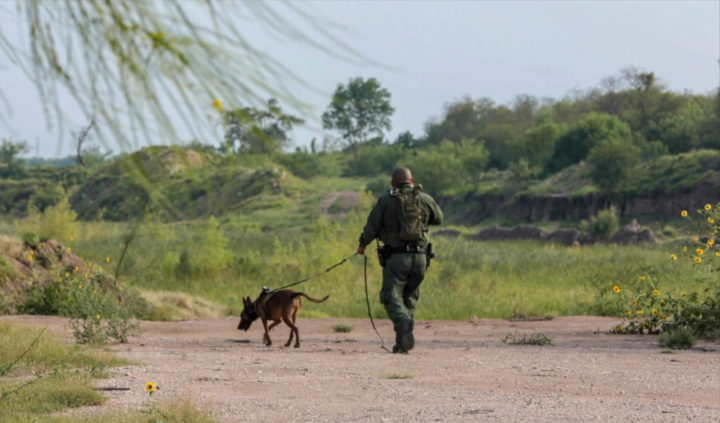
Border patrol searching fields in San Juan, TX. Photo: Garet Bleir
Claudia Patricia Gomez Gonzalez, a 20-year-old Indigenous Guatemalan woman, had made the over 1,500-mile journey to the US in order to pursue a job as an accountant and earn money for her college education. Known to her family as a “hard-working, studious, and caring young woman,” this young honors student was “well respected and known for her willingness to help and uplift those around her,” as noted in her parents’ claim. While she was successful in surviving the arduous journey to the US, her dreams were destroyed when she was brutally killed in Rio Bravo, Texas, by a Border Patrol agent who shot her in the head while she was unarmed.
Through an administrative claim – the prerequisite to bringing a lawsuit against the federal government – Claudia’s parents hold the US government liable for their daughter’s murder under the Federal Tort Claims Act (FTCA). If the claim is not resolved by the end of this year – 6 months after the filing of the claim – Claudia’s parents will be able to sue the US government and the agent responsible in federal court. “We will forever have an emptiness in our hearts because an agent of the US government took Claudia’s life in such a horrific and unnecessary way,” Gilberto Gomez Vicente, father of Claudia Gomez, said in a statement. “Claudia was a kind, loving, and peaceful girl with big dreams, who would never do anything to harm anyone. My promise to Claudia is to fight for justice so that her life is not forgotten, and her death is not in vain.”
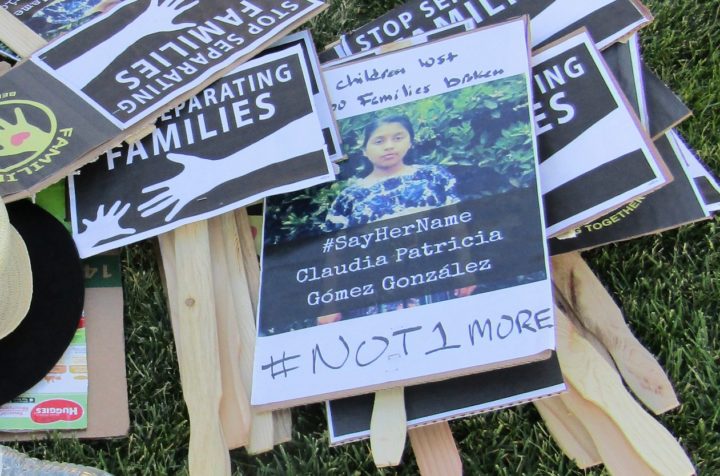
Protest signs at a rally in Orem, Utah. One features a photograph of Claudia Patricia Gomez Gonzalez. Photo: Ben P L on flickr (CC)
Claudia was traveling in the border town of Rio Bravo, Texas with several others shortly after crossing the border, when a Border Patrol agent confronted the group, according to attorneys in the filed claim. Claudia had neither weapons nor anything that would be perceived as one, and neither she nor members of her group acted threateningly or violently, according to the ACLU. But nevertheless, the agent drew his weapon, shooting the unarmed petite woman in the head.
As the claim explains, when confronted by the agent, two people within Claudia’s group ran toward the Rio Grande while two others ran toward an abandoned mobile home to hide. Claudia and one other remained. As the agent drew his weapon, Claudia took a step and the agent aimed, pulled the trigger, and fired, the claim states. Neither Claudia nor anyone else in Claudia’s group near her “created any threat of danger either—not to the agent, and not to anyone else,” according to the claim. No one other than the agent had any weapons.
After Claudia’s killing, CBP published a statement asserting that members of Claudia’s group used “blunt objects” as they attacked the Border Patrol agent, and Claudia was “one of the assailants.” But the organization later retracted this statement in lieu of a new one which no longer claimed Claudia had assaulted the agent and removed all mention of “blunt objects.”
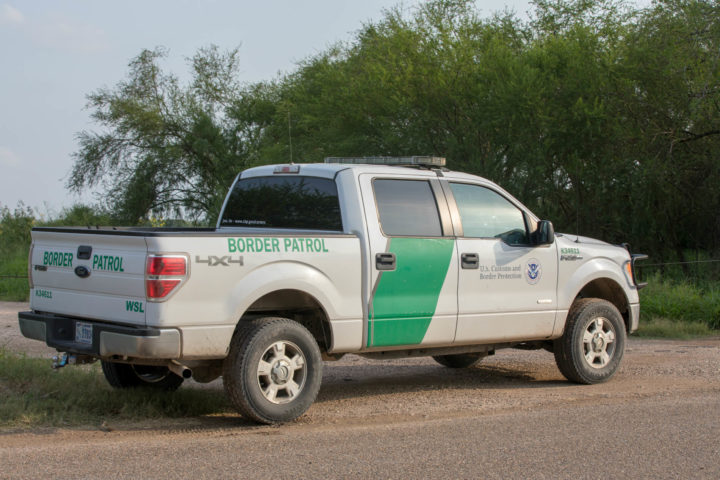
Border Patrol vehicle patrolling in San Juan, TX. Photo: Garet Bleir
“We are demanding justice for the senseless killing of Claudia Patricia Gómez González,” said Andre Segura, legal director for the ACLU of Texas. “It’s been more than a year, and the US Government still has not held the agency or the agent who shot and killed her responsible.”
In April of 2018, the Trump administration unveiled its “Zero Tolerance Policy,” which criminally charged adults crossing the border outside legal points of entry as a deterrent to others hoping to enter the US. In the past, apprehended families with children were kept together in ICE detention facilities, fitted with ankle bracelets and released to await their court hearings. After the policy was implemented, children were separated from their parents.
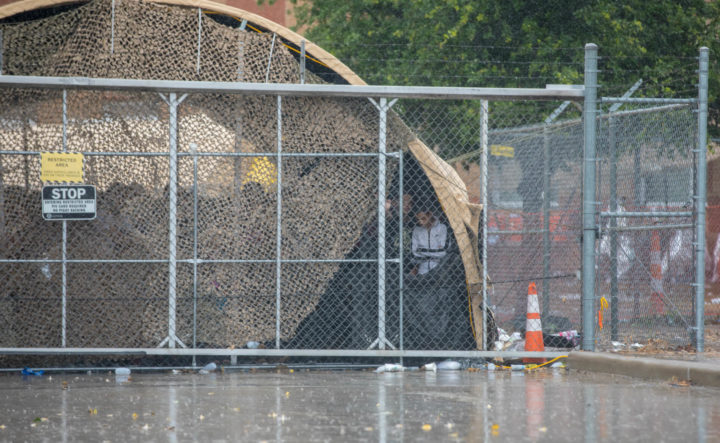
While awaiting processing, migrants, mostly women and young children, were forced to remain outside the U.S. Border Patrol McAllen, Texas Station through nearly 100° F heat and severe thunderstorms, protected by only thin mylar blankets and sleeping on the ground. Photo: Garet Bleir
The Justice Department identified at least 2,737 children who were separated due to the policy’s implementation. These children are now required to be reunited with their families due to a June 2018 federal court order. However, before the courts ordered the tracking of these separations, thousands of more children may have been separated–the current total of separated children is unknown due to a lack of an adequate tracking system by the Administration. Yet even after the June 2018 court order to halt the separations, at least 900 more children, including infants, were taken from their families. In mid-July of this year, through a motion filed in the US District Court in San Diego, the ACLU asked a federal judge to block the Trump Administration’s defiance of the court order.
New information on at least 2,648 children that the Trump Administration separated from their parents was provided in a report released this summer, titled, “Child Separations by the Trump Administration,” published by the House Committee on Oversight and Reform. The report covered those who had been separated since the initiation of the Administration’s Zero Tolerance Policy and who were still in custody as of June 26, 2018. Among the main findings: “The Trump Administration’s child separations were more harmful, traumatic, and chaotic than previously known…At least 18 infants and toddlers under two years old were taken away from their parents at the border and kept apart for 20 days to half a year; at least 241 separated children were kept in Border Patrol facilities longer than the 72 hours permitted by law; many separated children were kept in government custody far longer than previously known—at least 679 were held for 46 to 75 days, more than 50 were held for six months to a year, and more than 25 were held for more than a year.”
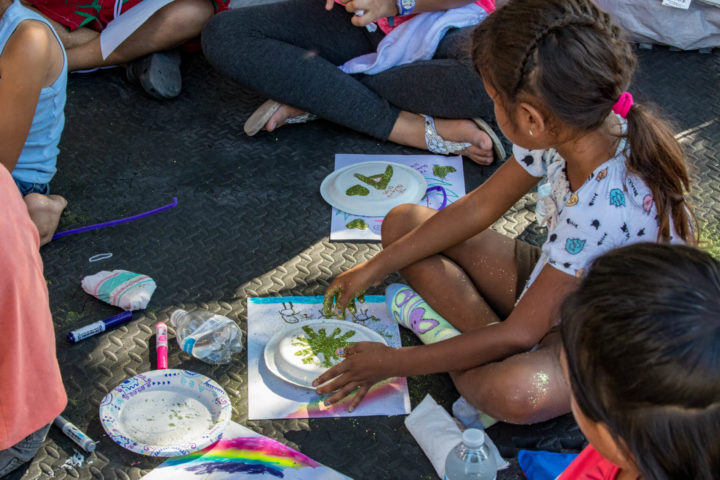
A young asylum seeker creating crafts during the Sidewalk School. Photo: Garet Bleir
This is all information that weighs heavily on the minds of families waiting in Mexico for their chance at obtaining asylum in the US.
“People do sometimes choose to cross illegally, because if they’re lucky they can try and have a sort of normal life — although it will never be normal because they’re going to be looking over their shoulder for the rest of their lives,” Ray says. “But for some people, it’s a better choice than to be put in the hands of the Border Patrol, and then God knows what happens with their kids.
“Sometimes families, they come in looking for a better future for the kids, but somehow they get to the border and are separated from their kids. This is the worst nightmare because all they wanted was a better future for them,” he adds. “People are worried. And with these new laws with the children being detained for so long; it’s on everybody’s mind.”

Cleaning up after crafts at the Sidewalk School. Photo: Garet Bleir
In October of 2018, five months after the court order to stop family separations, an Indigenous 12-year-old boy was taken from his father, according to an ACLU motion filed in July 2019 that asked a federal judge to halt the continued family separations. At the time, the government claimed he was unfit to care for his son due to mental health concerns. But, according to court filings, ACLU attorneys “received no information indicating that a child welfare or mental health expert made this determination.”
The attorneys believe that US officials’ inability to understand the Indigenous language spoken by the father may have led to inaccurate concerns regarding his mental health. ACLU attorneys identified no reasons that the family could not be safely reunited but the child’s father had already been quickly deported. His family feared that the boy wouldn’t be safe in his home country so instead of being reunited, he was handed over to a sponsor while he awaited his asylum decision.
In early 2019, an Indigenous Guatemalan father was separated from his 10-year-old child. The two fled Guatemala to seek asylum in the US after being persecuted in their homelands for reasons related to their Indigenous identity. The father had been involved in activism to defend his community’s ancestral homelands from a European hotel developer, who, according to the lawsuit, had issued an arrest warrant against him as part of a campaign directed against anyone in his community opposing the project. The mass arrest order was shown in the bond hearing to be issued “as part of a long-term effort by local officials to harass the indigenous community and deprive them of their hereditary rights to land ownership.” This was done through weaponizing corruption and the hotel developer’s influence on prosecutors in Guatemala. CBP officers used this warrant in order to separate the father and son, “without taking into account evidence that the arrest warrant—which accused 52 people of the same array of crimes—was baseless, as retaliation by [the father’s] persecutors in Guatemala, and was in fact part of the evidence that formed the basis of his asylum claim, as it showed that the Guatemalan government could not protect him,” according to ACLU attorneys.
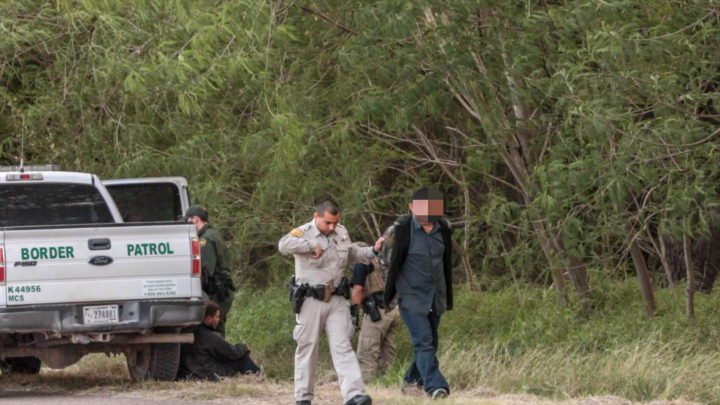
Border Patrol Detainment outside of the National Butterfly Center in Mission, TX. Photo: Garet Bleir
The child’s appointed advocate recommended “immediate reunification,” according to court documents. But it wasn’t until the attorneys were prepared to take the case to court that the government released the child to his father. During his six months of separation, the young boy began to forget his own language as he “suffered extreme isolation because of his inability to speak Spanish, English, or any language common in the shelter.”
Another Indigenous Guatemalan, referred to in testimony as “E.R.R.” and who the US government noted was without a criminal history, was detained by CBP with his one-year-old daughter. They were then placed in a facility with other children who were visibly sick, according to testimony from Las Americas Immigrant Advocacy Center Staff Attorney Nicolas Palazzo. This soon led to the sickness of his own infant. His daughter’s condition improved when he was given medicine after asking to be brought to a hospital. He administered the medicine each day to his daughter, according to CBP guards.
His infant was sleeping in his arms one day when she wet her diaper. As his daughter was still sick, the father wanted to let her continue sleeping, but a female guard told him “You are a bad father,” for not changing it. She then asked him, “Why did you bring your daughter here?” before separating the two without telling the father where his daughter was being taken or who she would be with, Palazzo testified. The daughter would be separated from her father for the next three and a half months.
In spite of this, Acting Homeland Security Secretary Kevin McAleenan has claimed that the separations of families remain “extraordinarily rare and under very controlled circumstances.”
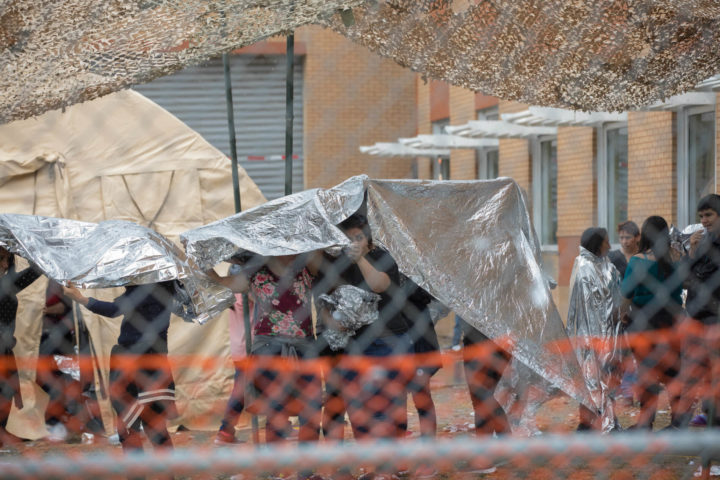
While awaiting processing, migrants, mostly women and young children, were forced to remain outside the U.S. Border Patrol McAllen, Texas Station through nearly 100° F heat and severe thunderstorms, protected by only thin mylar blankets and sleeping on the ground. Photo: Garet Bleir
In addition to the horrors of family separation, thousands of migrants were forced to endure abuse by the Rio Grande Border Patrol Sector in South Texas, as denoted in a complaint filed in May to officials within DHS from the ACLU of Texas and ACLU Border Rights. Through over 120 interviews conducted by the ACLU, staff noted an “extreme assault on their basic human rights” where asylum-seeking families were subject to dangerous and abusive conditions including outdoor detention with no protection from the rain, heat, or sun, and no access to medical attention, beds, or showers.
At the McAllen Border Patrol Station alone, more than 2,000 migrants, some with infants and toddlers, were held in outdoor pens in detention sometimes for over three days before being stationed indoors. While at the McAllen Border Patrol Station, IC observed migrants, mostly women and young children, being forced to remain outside while penned in front of the station through nearly 100° F heat and severe thunderstorms. Even during the rain, the asylum seekers were forced to sleep on the ground with nothing more than thin mylar emergency blankets. Yet some were not even provided that bare amenity. Many of these individuals reported to the ACLU that they were “forced to sleep on the muddy, rocky ground, and in puddles of water during thunderstorms, which were quickly followed by extreme heat, humidity and sun exposure.” A father with a three-year-old child told the ACLU he slept just an hour each night for three nights because they were forced to sleep on the ground with no cover from the heavy rains.
Others reported to the ACLU that agents conducted checks of the migrants every three hours, forcing them to stand and be counted. One family reported being held with up to 100 others for four days, saying that agents kicked anyone who fell asleep. Inside the facility, individuals reported that agents “screamed at them as if they were animals,” kicking those who laid on the ground in order to make space to fit more people into the indoor detention cells.
“A father was held outside for three days with his two-year-old son, who became listless with fever and chills following heaving rains. The father’s multiple requests for a doctor went unanswered for several days,” according to the report. “They wouldn’t even give us water when we asked for it. I stopped asking because they’d just ignore me,” the father stated. His son became increasingly ill as repeated requests for medical care were ignored, but eventually, the two were moved inside and finally offered flu medication. “The father was told that his insistence was the reason for the delay in his release from custody,” read the letter. One mother reported that her request for cough medicine was denied as an agent told her, “You’re not going to die from that.”
“Migrants reported requesting water for themselves and their sick children, with their requests being either denied or ignored,” the report reads. “Several people we interviewed stated they suffered from hunger due to insufficient food, as well as nausea from being forced to eat the same low-quality food for as many as nine days. Further, requests for more food were ignored by Border Patrol agents.”
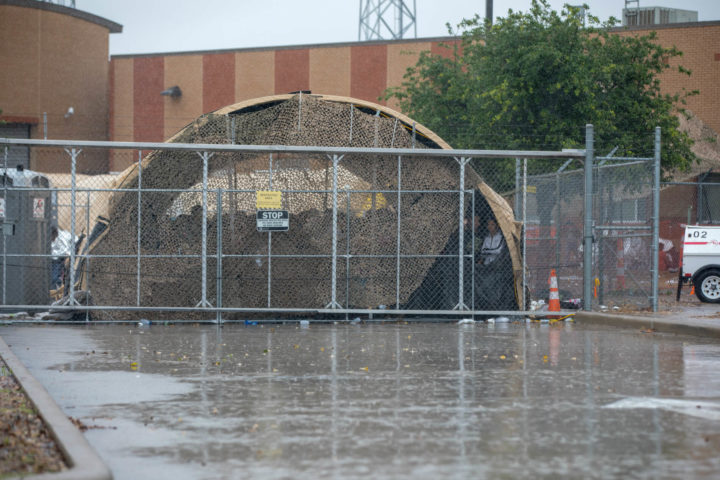
While awaiting processing, migrants, mostly women and young children, were forced to remain outside the U.S. Border Patrol McAllen, Texas Station through nearly 100° F heat and severe thunderstorms, protected by only thin mylar blankets and sleeping on the ground. Photo: Garet Bleir
Other reports included Border Patrol agents eating pizza while sitting outside cages where migrants were held and “taunting them, saying “Don’t you wish you could have some?” Migrants reported guards would aggressively bang their batons on the ground near where they were laying down to “scare and intimidate them,” as others reported threats from agents that they would be deported or separated from their families. “One mother reported agents forcing her to recite the national anthem of her country to prove her citizenship, threatening to separate her from her daughter, claiming her identity documents were false, and that she would be deported to her country where the gangs would kill her,” the report stated. “Several migrants, including a ten-year-old girl, identified one specific agent that would throw items at them, including blankets at their faces and bottles of water to the floor, forcing them to pick it up.”
From October 2014 to July 2018, 4,556 complaints of sexual abuse against migrant children held in US government custody had been reported, according to the Department of Health and Human Services documents released by Rep. Ted Deutch (D-FL). Of these reported assaults, 178 were reported to be from staff members at the facilities, with the majority of the assaults being reported against other minors in custody.
Since Trump’s inauguration, his administration has allowed at least 30 people to die in ICE custody or shortly after release, which according to migrant advocacy groups is due to the inhumane conditions they were held in. The oversight of ICE facilities has been called into question given that since 2012 no authorized ICE facilities have failed any inspections, including those where multiple individuals have died, according to a National Immigrant Justice Center study, which notes some of these deaths had later been reported to be a result of medical neglect. In fact, a 2015 analysis by the organization notes that after 2009, only one out of 100 facilities in post-2009 annual inspections had been given a “deficient rating.” Notably, 2009 is the same year that Congress passed a law requiring the government to halt contracts with immigrant detention facilities failing two consecutive inspections, the report notes.
This number does not include those held under other agencies, including at least seven migrant children that have died in US federal custody since last September, with five indigenous children dying in US federal custody since December. Most of the children died after getting sick inside United States detention centers.
One boy, Carlos Gregorio Hernandez Vasquez, a 16-year-old Indigenous Maya Achi minor from Guatemala, survived the over 1,000-mile journey from home alone without his parents. But after being held in CBP custody in South Texas for 6 days – twice as long as federal law requires – he died in the Weslaco Border Patrol Station after becoming sick with the flu in a central processing center in McAllen where there was a flu outbreak. He was never taken to a hospital during that time.
Despite these deaths and severe outbreaks of flu in South Texas facilities, CBP announced that they are declining to provide flu vaccines ahead of this year’s flu season. In a September letter signed by Elizabeth Warren (D-Mass), Bernie Sanders (D-VT), and several other hopefuls for the Democratic Presidential nomination along with other members of the Senate, signees denounced what they refer to as a “dangerous decision” that is both “immoral and irresponsible,” citing deaths of children in CBP to the flu already.
The US government has paid government-funded youth shelters to house immigrant children that have been separated from their families at the border or arrived unaccompanied. Many children have reported facing further abuse at these facilities. In one such facility, the Shiloh Treatment Center in Texas, without parental consent children were forcibly injected with psychotropic drugs – some of which had no FDA-approved uses for people below age 18 — and were physically abused, according to a lawsuit filed last year by the Center for Human Rights & Constitutional Law.
One child was placed on a dangerous combination of six psychotropic drugs and was at times forcibly medicated. The combination was “inconsistent with medical guidelines,” and four of the drugs had “very limited FDA-approved uses in children and adolescents,” according to the lawsuit. He was inappropriately medicated, according to an independent psychologist’s evaluation, resulting in side effects such as the child gaining nearly 100 pounds. After the child was transferred to another detention facility, both the child’s “health and behavior improved after his medications were reduced,” according to records referenced in the lawsuit. The Shiloh facility was owned and operated by the same company operating another treatment center in Texas that killed three teenagers from asphyxiation due to physical restraints between 1993 and 2002. A fourth child was killed at the facility in 2010 from asphyxiation from physical restraints, which was ruled a homicide.
“Some of the staff at Shiloh would provoke the children there and make us angry intentionally,” one child testified. “They made us act violently so then we had to be given shots. The staff would insult us and call us names like ‘son of a whore,’” continuing that two staff members at the facility were violent towards him. “One was a teacher who… called the medical staff to the classroom to give me shots many times. One time, I got angry in class and wanted to leave the classroom. I was sitting down, but he came and touched me so I got angrier. Then he grabbed me and twisted my arm behind my back then lifted up so I felt like my shoulder was breaking. I screamed. The teacher had done the same thing to one of my friends.” He explained that the staff member would call the medical staff who would then come and give him a shot to “tranquilize me,” noting that this happened many times. “They would give me the shot and then I would start to feel sleepy and heavy, and like I didn’t have any strength. I would sleep for three or four hours and then wake up and slowly start to feel my strength return. When they did that, they left me in the classroom near the wall to sleep.” The child said that the staff did the same to one of his friends.
The child also testified that another staff member at Shiloh had physically been violent with him. “When he grabbed me, he would bend my hand all the way back so it almost touched my wrist,” the child stated. “It really hurt. I almost cried, but he just laughed.”
“I wanted to stop taking all the medication they were giving me at Shiloh but when I told the doctors that, they told me that I had to continue because it calmed me,” he added. “I said the problem is this place, it makes me angry. I was so scared there.”
A federal judge ruled last year that the government may no longer administer these drugs without obtaining a court order prior to its administration or by receiving consent from a parent or guardian.
Some claim that the ideologies of white supremacy touted by the leaders of the US and its immigration system have a direct effect on the abuse of people at its southern border: Ken Cuccinelli, acting director of US Citizenship and Immigration Services, himself had made racist and inaccurate claims regarding the inscription on the Statue of Liberty. He claimed the inscription, which welcomes immigrants to the US, is referring to Europeans, as opposed to other immigrants. The actual inscription on the Statue of Liberty in part reads “Give me your tired, your poor, your huddled masses yearning to breathe free.”

Ken Cuccinelli speaking at the 2013 Conservative Political Action Conference (CPAC). Photo: Gage Skidmore on flickr (CC)
Cuccinelli’s statement came just a day after the Trump Administration announced its decision to deny green cards to migrants seeking public assistance such as Medicaid, that was set to go into effect Oct. 15. On Oct. 4, the White House released an update to this plan via the “Presidential Proclamation on the Suspension of Entry of Immigrants Who Will Financially Burden the United States Healthcare System,” which sought to bar legal immigrants from remaining in the United States if they are unable to prove they will have sufficient health care coverage within 30 days of their arrival in the US. The decision was blocked by a federal judge on Oct. 11.
These immigration policies and ideological stances have also been highlighted through the way the Administration decides to focus its deportation efforts and resources. On Aug. 7, around 680 workers were taken from their jobs, detained, and separated from their family members as immigration raids conducted by ICE swept through food-processing plants in Mississippi. This was the largest single-state immigration enforcement action in the history of the US. The immigration raids happened only hours before Trump visited El Paso, Texas, where days earlier a white supremacist, anti-immigrant, Trump-supporting mass shooter killed 22 people in response to his ahistorical view of a “Hispanic invasion of Texas.” Some racist language used in the mass shooter’s manifesto had also been spouted throughout Trump’s election campaign and presidential term, with immigrant advocates holding Trump responsible in part for emboldening white supremacists to violent action throughout the US.
Koch Foods, which runs one of the raided plants, is one of the leading poultry processors in the US, employing over 13,000 across six states, including their Mississippi plant. The raid came one year after Koch Foods had to settle an EEOC lawsuit charging the company with sexual harassment, national origin discrimination, race discrimination, as well as retaliation against a class of Hispanic workers at their Morton, Miss. plant.
The company put individuals, classes of Hispanic employees, and female employees in hostile working environments, subjecting them to discriminatory treatment due to their Hispanic identity and targeting females, including both sexual and physical assaults, as outlined in the lawsuit. The company retaliated against a class of Hispanic employees by firing them or subjecting them to “other adverse actions” after they had made a complaint. According to a statement by the EEOC, “supervisors touched and/or made sexually suggestive comments to female Hispanic employees, hit Hispanic employees and charged many of them money for normal everyday activities” like using the bathroom. Additionally, court filings show that supervisors threatened to turn in undocumented workers to authorities if they spoke out regarding their concerns, according to a report by Reuters.
These reports have incited labor and immigration activists to call out the raid as a tool to further silence workers — specifically undocumented workers — who have united to fight unjust conditions in the workplace. But the company claimed in a statement that they “had no part whatsoever in the raid,” had no forewarning of its occurrence, and in response to its relation to the EEOC case released a statement that non-definitively claimed, “The raid does not relate to a prior EEOC case to Koch Foods’ knowledge.”
According to a statement released by ICE, “In all cases, all the illegal aliens encountered as part of this operation are either being placed into removal proceedings before the federal immigration courts, and for those who already received due process and have been ordered removed, processed for removal from the US.”
Undocumented immigration at the US-Mexico border is not the primary cause of illegal immigration, but rather illegal overstays on visas. As noted in a report released in early 2019 by the Center for Migration Studies, the population of undocumented immigrants continued to fall from 2016 to 2017, while visa overstays significantly exceeded illegal border crossings for the seventh consecutive year. The report also notes that Mexico was the leading country in visa overstays in 2017, yet according to a 2017 study by PEW Research Center the number of Mexican immigrants living in the US illegally has declined by two million since 2007 and according to a 2015 report by the center, more Mexicans are returning to their home country than are migrating to the US since the end of 2009.
Current border apprehensions — surpassing 310,000 in FY 2017 — are far less than historic highs, which reached 1.6 million in the year 2000, according to CBP data. Notably, the Center for Migration Studies report shows that the total arrivals from Mexico and Central American countries far exceeds undocumented arrivals.
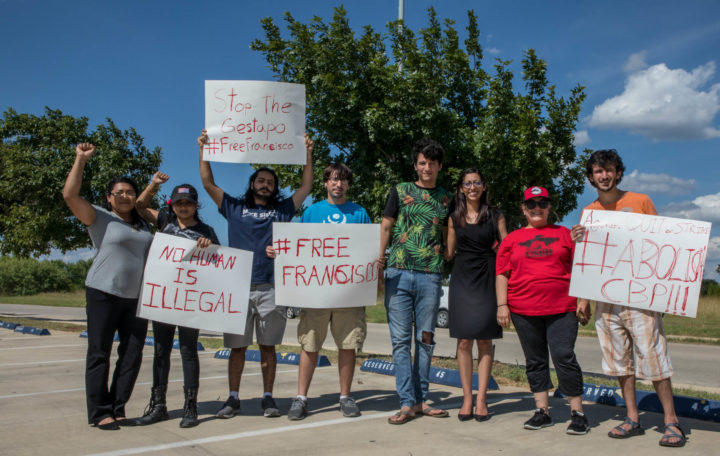
Francisco Galicia standing with his attorney, candidate for the U.S. Senate from Texas Sema Hernandez, and immigration activists who came to assure Francisco was released. Photo: Garet Bleir
With this in mind, critics charge that the true aim of the Trump Administration’s hyper-focus on policies and border wall structures directed at undocumented immigrants at the US-Mexico border is rooted in race-based discrimination, echoing the same xenophobic and racist sentiments used during Trump’s race-charged campaign that fueled his way to the presidency.
This is further exemplified by US citizens who have been subject to detainment. On July 23, Francisco Erwin Galicia, a high school senior born in Dallas, Texas, called his mother for the first time after being released from nearly a month of illegal detainment in US detention centers at the hands of CBP and ICE. He was held in “inhumane and unexplainable” conditions, he told IC and others present at his release, losing over 25 pounds in several weeks. “I didn’t live this experience alone; there are many living this very horrible experience,” he added.
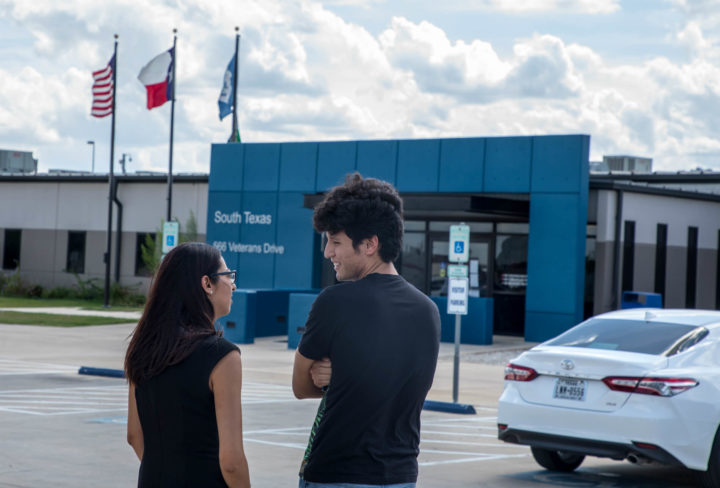
Francisco Galicia speaking with his attorney Claudia Galan in front of the South Texas Detention Center after being released from nearly a month of detainment. Photo: Garet Bleir
Galicia, a US-born citizen, was detained by Border Patrol on June 27 at a checkpoint in Falfurrias, Texas while driving with his brother and friends on their way to a college soccer scouting event. At the checkpoint, he showed Border Patrol agents proof of his birth in the US that he had with him — his Texas State ID, his wallet-sized birth certificate, and his social security card, but the agents told him they believed the documents weren’t real, says his attorney Claudia Galan. For the entire three weeks he was held captive in CBP custody, Francisco was not allowed to use the phone, even for calls to his attorney or to his mother, who feared he would be deported.
Throughout the course of his stay in CBP custody, he was encouraged to sign documents to voluntarily deport himself to Mexico—which he almost did due to the conditions he experienced.
It wasn’t until three weeks after being detained, after being transferred to ICE custody, that he was allowed to make a collect phone call.
Despite multiple attempts by family members and his attorney to give further proof of his US citizenship, it wasn’t until Galan took this to the news media and grassroots activists throughout Texas that ICE finally released Francisco, Galan says.
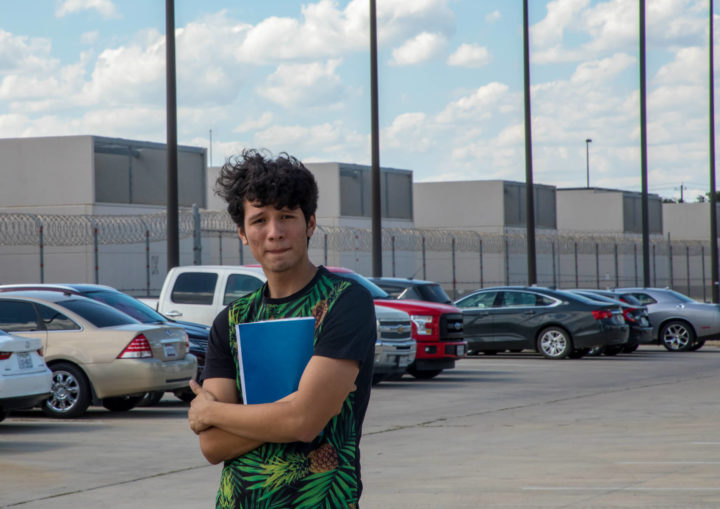
Francisco Galicia in front of the South Texas Detention Center after being released from nearly a month of detainment. Photo: Garet Bleir
Galan was told that once she arrived at South Texas Detention Complex in Pearsall, she would have to present his documents again and be present for an interview the Deportation Officer wanted to conduct. But when she arrived, this time joined by a handful of activists and reporters, IC along with others present watched as ICE officials released Francisco without requiring further documentation or speaking to the attorney. This lends further weight to the belief that the officials not only had the proper documentation for Francisco’s release, they also knew that they had the proper documentation and that he was a US citizen.
At the end of September, ICE delivered a letter to the 18-year-old notifying Francisco that his case was filed with an immigration judge, according to Galan. This means that his deportation proceedings are moving forward, she says. She believes they are prosecuting his case because he doesn’t have a US passport and has an additional birth certificate in Mexico. His mother moved to Mexico with Fransisco when he was a few months old, and when Fransico was a three-year-old she registered him for and obtained a Mexican birth certificate for him so that he could go to school in Mexico.
ICE reported a nearly 40,000 average daily detention population in November of 2017, according to federally requested data analyzed by the NIJC, which at the time was the second year in a row that detained immigrants reached record highs. By Jan 1., ICE was detaining 48,000, according to a Buzzfeed report, and by late August was detaining a new high of over 55,000 people — even though in February, Congress’ bipartisan bill told the agency to decrease its number of detainees from around 49,000 down to just over 40,500 by October, according to a report by Mother Jones.
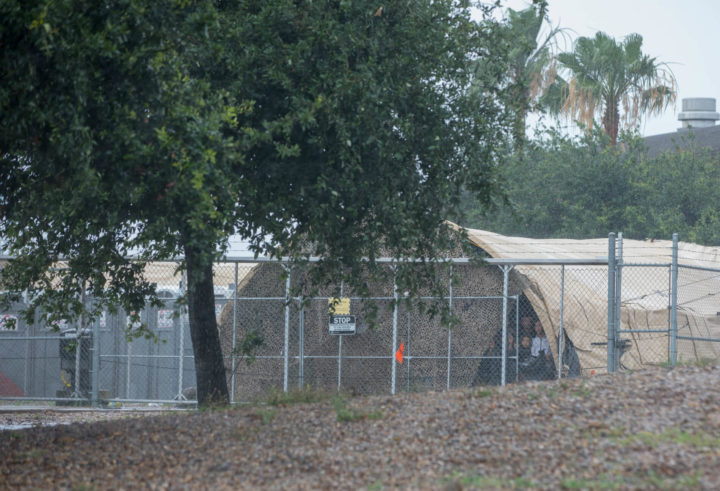
While awaiting processing, migrants, mostly women and young children, were forced to remain outside the U.S. Border Patrol McAllen, Texas Station through nearly 100° F heat and severe thunderstorms, protected by only thin mylar blankets and sleeping on the ground. Photo: Garet Bleir
Even with these record highs of detainment, the total number of migrants crossing the southern border is still far less than the historic highs from the 1980s through to the mid-2000s. Of the November 2017 detainees, the NIJC analysis notes that over 70 percent were held in private detention centers run by for-profit companies such as GEO and CivicCore. This rises slightly over the previous year’s private detention population during the Obama Administration when, according to the latest reported federal data by the Homeland Security Advisory Council in 2016, over two-thirds of ICE detainees were held in private detention centers.
In a report by the DHS Office of the Inspector General dated Feb. 21, 2018, it was noted that in order to establish the South Texas Family Residential Center in Dilley, Texas, ICE improperly modified an existing agreement with the City of Eloy, Arizona, located over 900 miles away and whose “sole function under the modification is to act as the middleman between ICE and CCA,” the private company that operates the South Texas Family Residential Center.” The City of Eloy collected approximately $438,000 in annual fees for this function when ICE could have contracted directly with the private company operating the facility. The report thus determined that “ICE may have overpaid for detention services at the South Texas Family Residential Center, as well as other detention facilities. Moreover, ICE has no assurance that it executed detention center contracts in the best interest of the Federal Government, taxpayers, or detainees.”
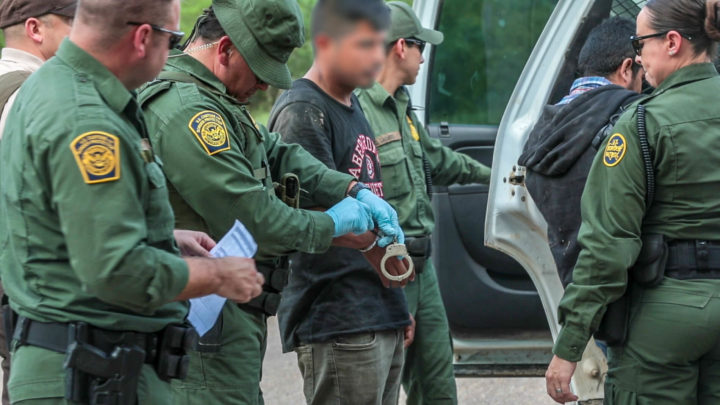
Border Patrol detainment just outside the Eli Jackson Cemetery in San Juan, TX where the Carrizo/Comecrudo Tribe has set up a village in resistance to the border wall and in protection of final resting places of Esto’k Gna ancestors and relatives. Photo: Garet Bleir
Even after a congressional order to stop detaining so many immigrants, ICE increased its detainee population to record highs, as reported by Mother Jones. Even though Congress had rejected an ICE request for more detention funds, the agency pushed past that decision as it began to use three new for-profit immigration detention centers in South Texas this summer. The report notes that one of the centers had previously “seen the death of three inmates following poor medical treatment and a violent riot in 2012 that left a guard dead.” Additionally, a report by the Daily Beast noted that in 2018, more than $800 million of US taxpayer money was paid to 19 private for-profit detention centers, housing around 18,000 migrants, over 40 percent of the total migrants held by ICE at the time.
The detention length for immigrants has been significantly longer across private facilities, which have approximately 175 percent more grievances when compared with non-privately operated facilities when controlled for various external factors, according to a December 2018 analysis by the American Immigration Council.
In a large win for immigrant advocates, a new law in California signed by Gov. Gavin Newsom on Oct. 11 has required the state to phase out current private prisons, including for-profit immigrant detention centers, by 2028, and will ban new contracts and contract renewals for the facilities starting Jan. 1 of 2020.
There isn’t much hope of reform for the Trump administration’s corrupt immigration system and the culture of abuse it has espoused. However, many victories are compounding against the systemic and callous disregard of migrants and asylum seekers who are only looking for a better life for themselves and their families.
But it’s not enough. As Zavala told IC, all US citizens have a part to play in making sure the government stands up for truth and justice.
“US policy is complicit in the deaths of the migrants and it’s complicit to contributing to organized crime,” says Zavala. “We’re almost giving organized crime a business by the policies that we’re creating. So the next time that we think of who is going to lead us, who is going to represent us, who are we electing to Congress and who are we, we need to look at what policies they have been voting on.” That’s especially true when it comes to the policies that led to this disaster, because she says, that is reflective of the person’s morality.
“These policies sound like they’re for the well-being of everybody, but what we’re seeing here as a community of humanitarian efforts and border relief efforts, we’re seeing how those policies translate to real life and reality – and it’s absolutely horrid. The only people that know the truth are the people that go across and see this. The government is keeping these atrocities under wraps and presenting them [at] a level that we can handle as a society. But in reality, I cannot handle it. We cannot handle this.
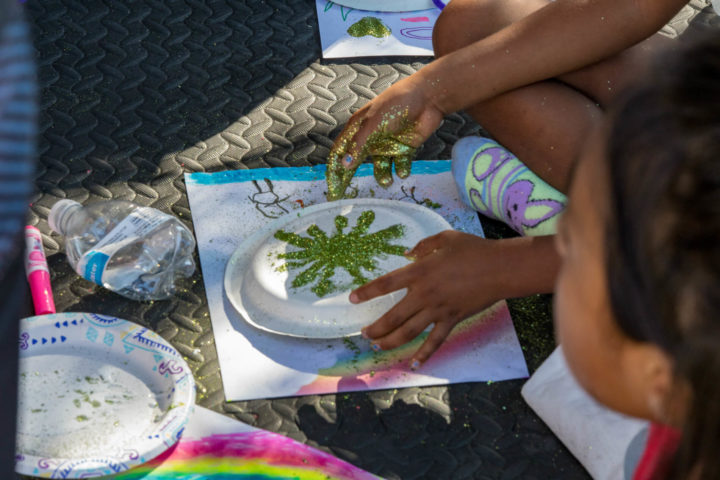
A young asylum seeker making crafts during the Sidewalk School. Photo: Garet Bleir
Follow Garet Bleir Journalism on Facebook or @GaretBleir on Instagram and Twitter for videos, podcasts, and long-form article updates to come regarding these issues and published with Intercontinental Cry.

Indigenous Peoples are putting their bodies on the line and it's our responsibility to make sure you know why. That takes time, expertise and resources - and we're up against a constant tide of misinformation and distorted coverage. By supporting IC you're empowering the kind of journalism we need, at the moment we need it most.